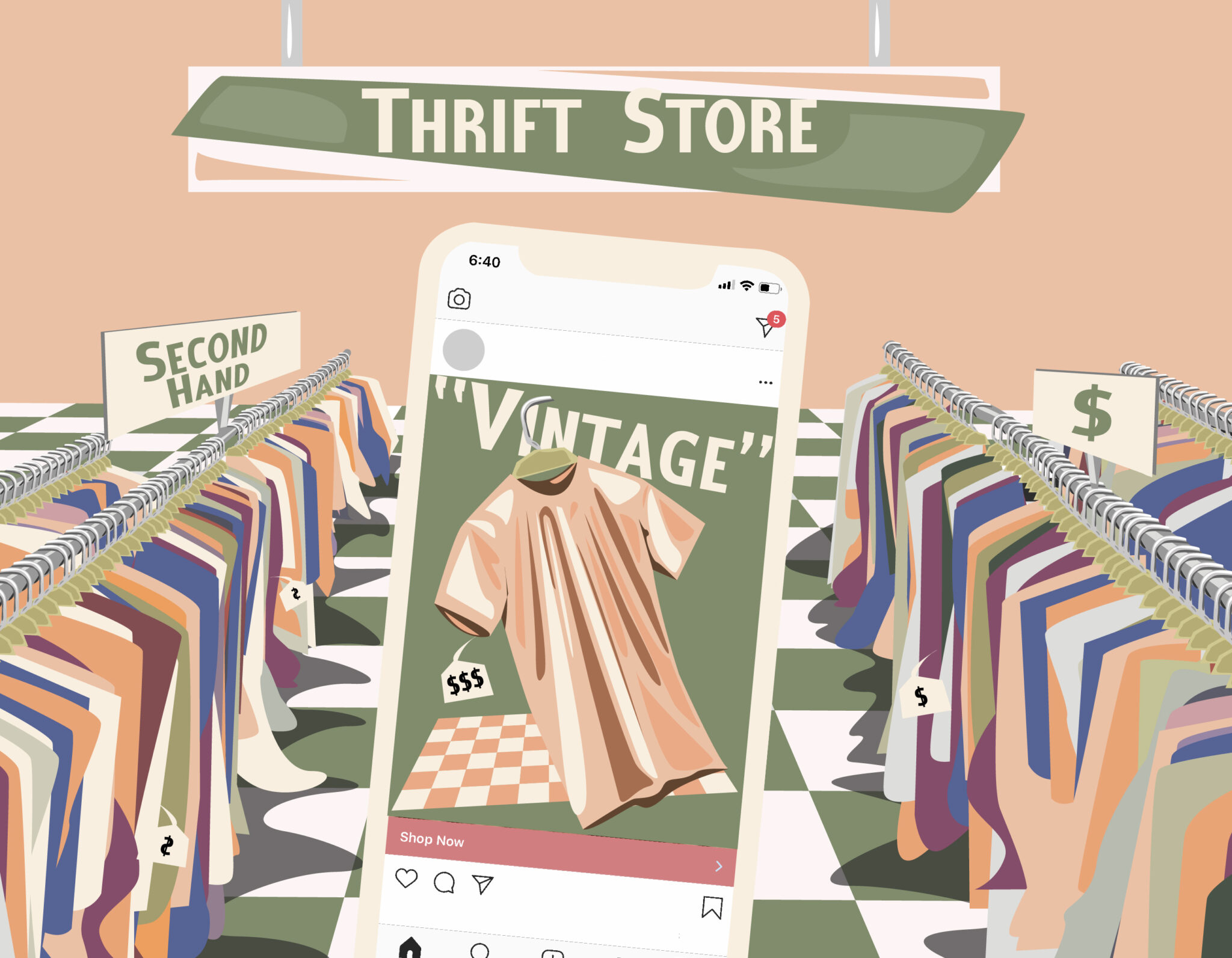GRAPHIC DESIGN Brennan March
The world of fashion, as we know it today, is the second largest polluter in the world, only behind the oil industry. Whether you care for fashion or not, we all contribute to it through the everyday clothes we wear and the waste it produces. In recent years, sustainability has been a topic of interest for many people, particularly Millennials and Gen Z, yet at the same time, fast fashion continues to thrive; fads change so quickly and the low prices of fast fashion items attracts those who want to be trendy on a budget. The mix of interest in sustainability and being trendy has created a consumer culture in which sustainability has now become a trend. As a result of this, young and wealthy people have turned to thrifting, which is a great way to find quality products for an affordable price, but in a way that defies the purpose of shopping second-hand by capitalizing on that lifestyle. Low-income folks have been going to thrift stores for their clothes and household items for years, but now that sustainability, therefore thrifting, has become fashionable, it has become more difficult for them to find good products due to the lack of options.
Depop is a marketplace app where you can sell your items, with a portion of your profits going to the company. Since its creation in 2011, it has accumulated over 13 million users who both shop and resell items, mainly clothing. Similar apps include Poshmark, Carousell, and even Instagram. It’s a great place to find cute items like used overalls or authentic Prada bags. A lot of the clothing for sale is advertised as thrifted “vintage” finds and many accounts sell hundreds of pieces; these same accounts boast about their “sustainably sourced clothing,” yet resell “vintage” Brandy Melville tops from a year ago. Here are some reasons why your Depop may be problematic:
1. Calling something “vintage” just because they aren’t from this season does not make it vintage. It’s false advertising and if you are reselling fast fashion clothing from companies like Topshop or Zara, it most likely won’t survive another year.
2. If you have hundreds of items on your profile, it probably means you went out of your way to buy those items for the sole purpose of reselling them and making a profit. Buying on-trend clothing for cheap just to make a profit empties out thrift stores and leaves very little options for those who can only afford to shop at those stores. Snaps for entrepreneurship, but you are not being innovative, you are just following a trend.
3. Buying a $3 XXL t-shirt from Value Village and reselling it for $20 to skinny people for the aesthetic takes that opportunity away from a person whose only option to find a XXL t-shirt is by going to a second-hand store. It’s not an oversized t-shirt, it’s a t-shirt made for larger people.
4. By over-buying and raising demand, stores like Goodwill have capitalized on that market and increased their prices; a t-shirt that was once $3 is now $7. That $4 difference may not be a big deal to middle and upper class people, but if you are from a low-income family and want to buy 5 t-shirts for your relatives, your new total would be $35 instead of $15, which is a 134% increase.
5. If sustainability is your argument, over-buying more desirable items leave very little options for those who actually need them. From the lack of options, low-income folks then look towards shopping at fast-fashion retailers where they can buy trendy clothing for a similar price; this then increases the demand for fast fashion clothing, which then contributes to even more waste and pollution. Do you see the irony?
I am not telling you to never thrift or resell your used clothing, I’m just shedding some light into why capitalizing on and gentrifying thrifting is not as sustainable as you think it is. It’s great to buy from thrift stores! It definitely is more environmentally friendly than buying brand new, but I encourage you to think about why you’re thrifting: are you doing it to expand your closet and experiment with different styles, or are you doing it to gain a profit? If you are only thrifting to make a profit, think about how you’re impacting low-income folks and the environment you say you care about. If you are privileged enough to have the option of not buying from a thrift store, use that privilege to help those who don’t have a choice. Donate to your local thrift store and if you do decide to resell items, donate a portion of your sales to organizations that help low-income folks. If you want to buy sustainable clothing, buy from local brands with ethical values and practices like Tamga Designs (in lieu of Anthropologie), Frank and Oak (for everyday essentials (and my favourite jeans!)), and Arc Apparel (instead of Urban Outfitters). The price for sustainable and ethical clothing may be a much higher one than fast fashion or thrifting, but it is because they pay their workers a proper wage and source their materials locally. In the end, those pieces will make up for their high prices through their long-lasting wear and that guilt-free feeling!


























